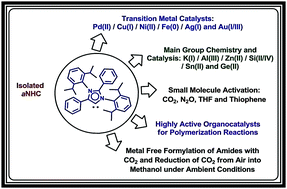Stable abnormal N-heterocyclic carbenes and their applications
Abstract
Although N-heterocyclic carbenes (NHCs) have been known as ligands for organometallic complexes since the 1960s, these carbenes did not attract considerable attention until Arduengo et al. reported the isolation of a metal-free imidazol-2-ylidene in 1991. In 2001 Crabtree et al. reported a few complexes featuring an NHC isomer, namely an imidazol-5-ylidene, also termed abnormal NHC (aNHCs). In 2009, it was shown that providing to protect the C-2 position of an imidazolium salt, the deprotonation occurred at the C-5 position, affording imidazol-5-ylidenes that could be isolated. Over the last ten years, stable aNHCs have been used for designing a range of catalysts employing Pd(II), Cu(I), Ni(II), Fe(0), Zn(II), Ag(I), and Au(I/III) metal based precursors. These catalysts were utilized for different organic transformations such as the Suzuki–Miyaura cross-coupling reaction, C–H bond activation, dehydrogenative coupling, Huisgen 1,3-dipolar cycloaddition (click reaction), hydroheteroarylation, hydrosilylation reaction and migratory insertion of carbenes. Main-group metal complexes were also synthesized, including K(I), Al(III), Zn(II), Sn(II), Ge(II), and Si(II/IV). Among them, K(I), Al(III), and Zn(II) complexes were used for the polymerization of caprolactone and rac-lactide at room temperature. In addition, based on the superior nucleophilicity of aNHCs, relative to that of their nNHCs isomers, they were used for small molecules activation, such as carbon dioxide (CO2), nitrous oxide (N2O), tetrahydrofuran (THF), tetrahydrothiophene and 9-borabicyclo[3.3.1]nonane (9BBN). aNHCs have also been shown to be efficient metal-free catalysts for ring opening polymerization of different cyclic esters at room temperature; they are among the most active metal-free catalysts for ε-caprolactone polymerization. Recently, aNHCs successfully accomplished the metal-free catalytic formylation of amides using CO2 and the catalytic reduction of carbon dioxide, including atmospheric CO2, into methanol, under ambient conditions. Although other transition metal complexes featuring aNHCs as ligand have been prepared and used in catalysis, this review article summarize the results obtained with the isolated aNHCs.



 Please wait while we load your content...
Please wait while we load your content...